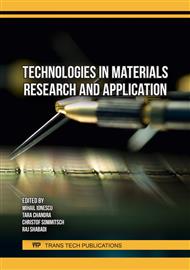[1]
https://de.wikipedia.org/wiki/Trinkwasser
Google Scholar
[2]
https://www.wassertest-online.de/blog/schwermetalle-im-trinkwasser/
Google Scholar
[3]
G. E. McDonnell: Antisepsis, Disinfection, and Sterilization: Types, Action, and Resistance. Blackwell Publishing, 2007, ISBN 978-1-55581-392-5
DOI: 10.1128/9781555816445
Google Scholar
[4]
https://www.eppendorf.com/product-media/doc/de/59828/Eppendorf_Detection_Application -Note_279_BioPhotometer-D30_Detection-contamination-DNA-protein-samples-photometric-measurements.pdf [Internet retrieved: 20.09.2022 – 16:00]
Google Scholar
[5]
https://www.watt24.com/ratgeber/uv-lampen-desinfektion-leicht-gemacht/ [Internet retrieved: 21.09.2022 – 17:00]
Google Scholar
[6]
Moses Nelson Baker: The Quest for Pure Water: The History of Water Purification from The Earliest Records to The Twentieth Century. 2. Auflage. American Water Works Association, Denver 1981, ISBN 978-0-89867-247-3
Google Scholar
[7]
https://www.infektionsschutz.de/infektionskrankheiten/erregerarten/bakterien/ [Internet retrieved: 01.03.2023 – 18:00]
Google Scholar
[8]
https://www.wotech-technical-media.de/womag/onlineartikel/OA-2018/11-November18/26_11_Quecksilber.php [Internet retrieved: 16.03.2023 – 16:00]
Google Scholar
[9]
https://www.ikts.fraunhofer.de/content/dam/ikts/downloads/jahresberichte/jb2014/51_Elektrochemische_Verfahren_f%C3%BCr_Wasserbehandlung_und_Rohstoffrecycling.pdf [Internet retrieved: 16.03.2023 – 17:00]
Google Scholar
[10]
https://temperatur-profis.de/temperaturfuehler/temperatursensor-funktionsweise/
Google Scholar
[11]
https://www.rechner-sensors.com/dokumentation/wissen/der-temperatursensor
Google Scholar
[12]
https://www.test-wasser.de/elektrische-leitfaehigkeit-wasser [Internet Received 26.03.2023 14:00]
Google Scholar
[13]
Kurt Marquardt u. a: Rein- und Reinstwasseraufbereitung. Expert-Verlag, (1994)
Google Scholar
[14]
https://info.hannainst.de/parameter/leitfaehigkeit-erklaert [Internet Received 27.03.2023 14:00]
Google Scholar
[15]
https://www.internetchemie.info/chemie-lexikon/t/tds-wert.php [Internet Received 17.04.2023 17:00]
Google Scholar
[16]
Roger Schmid, SWAN Analytische Instrumente AG, Hinwil, Schweiz: Verfahren in der TOC-Messung, Pharm. Ind. 75, Nr. 11, 1840 – 1848 (2013)
Google Scholar
[17]
https://de-academic.com/dic.nsf/dewiki/1106024#Anwendungens [Internet Received 17.04.2023 18:00]
Google Scholar
[18]
https://home.uni-leipzig.de/energy/energie-grundlagen/16.html [Internet Received 18.04.2023 12:00]
Google Scholar
[19]
Dirk Flottmann, Detlev Forst, Helmut Roßwag: Chemie für Ingenieure: Grundlagen und Praxisbeispiele. Springer, 2003, ISBN 3-540-06513-X, S. 225.
DOI: 10.1007/978-3-642-18545-8
Google Scholar
[20]
W. Bermbach: Die Vorgänge im ruhenden Bleisammler. In: Die Akkumulatoren. Springer, Berlin / Heidelberg 1929, S. 65 ff.;
DOI: 10.1007/978-3-662-29115-3_4
Google Scholar
[21]
http://fmh-studios.de/theorie/informationstechnik/i2c-bus/ [Internet Received 28.03.2023 19:00]
Google Scholar
[22]
https://www.grund-wissen.de/elektronik/arduino/aufbau.html [Internet Received 29.03.2023 15:00]
Google Scholar
[23]
Berger, Hartmann, Schmid: Additive Fertigungsverfahren – Rapid Prototyping, Rapid Tooling, Rapid Manufacturing. 1. Auflage. Verlag Europa-Lehrmittel, Haan-Gruiten 2013, ISBN 978-3-8085-5033-5.
DOI: 10.1007/978-3-446-43652-7_5
Google Scholar
[24]
Andreas Gebhardt: Rapid Prototyping – Werkzeuge für die schnelle Produktentstehung. 2. Auflage. Hanser Verlag, München 2000, ISBN 3-446-21242-6.
Google Scholar
[25]
M. Heinrich, A. Foitzik, Low Cost Easy-To-Use UV-C-diode Testing Device via Rapid Prototyping; Fachtagung Mikrosystemtechnik & Mikroelektronik (2022)
Google Scholar
[26]
M. Heinrich, A. Foitzik, A conductivity-based, batch-optimized system for analyzing the total of carbon parameter in water, Fachtagung NWK 23 HS Harz
Google Scholar
[27]
https://www.elektronik-kompendium.de/sites/kom/2405151.htm [Internet Received 26.04.2023 15:00]
Google Scholar




